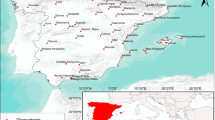Abstract
The measuring stations of a geophysical network are often spatially distributed in an inhomogeneous manner. The areal inhomogeneity can be well characterized by the fractal dimension D H of the network, which is usually smaller than the euclidean dimension of the surface, this latter equal to 2. The resulting dimensional deficit, (2 − D H ), is a measure of precipitating events which cannot be detected by the network. The aim of the present study is to estimate the fractal dimension of a rain-gauge network in Tuscany (Central Italy) and to relate its dimension to the dimensions of daily rainfall events detected by a mixed satellite/radar methodology. We find that D H ≃ 1.85, while typical summer precipitations are characterized by a dimension much greater than the dimensional deficit 0.15.




Similar content being viewed by others
References
Forrest SR, Witten TA (1979) Long-range correlations in smoke-particle aggregates. J Phys A (Math Gen) 12:L109–L117
Garcia-Herera R, Hernandez E, Paredes D, Barriopedro D, Correoso J, Prieto L (2005) A mascote-based characterization of MCSs over Spain, 2000–2002. Atmos Res 73:261–282
Grassberger P, Procaccia I (1983a) Characterization of strange attractors. Phys Rev Lett 50:346–349
Grassberger P, Procaccia I (1983b) Measuring the strangeness of strange attractors. Physica D 9:189–208
Johnson RH, Gallus Jr WA, Vescio MD (1990) Near-tropopause vertical motion within the trailing stratiform region of a midlatitude squall line. J Atmos Sci 47:2200–2210
Kolios S, Feidas H (2007) Correlation of lightning activity with spectral features of clouds in Meteosat-8 imagery over the Mediterranean basin. In: Proceedings of the 8th Pan-Hellenic geographical congress, Athens, Greece
Kolios S, Feidas H (2010) A warm season climatology of mesoscale convective systems in the Mediterranean basin using satellite data. Theor Appl Climatol 102:29–42
Korvin G, Boyd DM, O’Dowd R (1990) Fractal characterization of the south australian gravity station network. Geophys J Int 100:535–539
Liebovitch LS, Toth T (1989) A fast algorithm to determine fractal dimensions by box counting. Phys Lett A 141:386–390
Lovejoy S, Schertzer D, Ladoy P (1986) Fractal characterization of inhomogeneous geophysical measuring networks. Nature 319:43–44
Mandelbrot BB (1982) The fractal geometry of nature. Freeman, San Francisco
Mazzarella A, Tranfaglia G (2000) Fractal characterisation of geophysical measuring networks and its implication for an optimal location of additional stations: an application to a rain-gauge network. Theor Appl Climatol 65:157–163
Morel C, Senesi S (2002) A climatology of mesoscale convective systems over europe using satellite infrared imagery. II. Characteristics of European mesoscale convective systems. Q J R Meteorol Soc 128:1973–1995
Olsson J, Niemczynowicz J (1996) Multifractal analysis of daily spatial rainfall distributions. J Hydrol 187(1–2):29–43
Ouchi T, Uekawa T (1986) Statistical analysis of the spatial distribution of earthquakes-variation of the spatial distribution of earthquakes before and after large earthquakes. Phys Earth Planet Inter 44:211–225
Strogatz SH (1994) Nonlinear dynamics and chaos: with applications to physics, biology, chemistry and engineering. Perseus Books, Reading, pp 409–412
Tessier Y, Lovejoy S, Schertzer D (1994) Multifractal analysis and simulation of the global meteorological network. J Appl Meteorol 33(12):1572–1586
Tsonis AA, Triantafyllou GN, Elsner JG (1994) Searching for determinism in observed data: a review of the issue involved. Nonlinear Process Geophys 1:12–25
Acknowledgements
MSG imagery is copyright of EUMETSAT and was made available by the EUMETSAT on-line Archive. We thank National Department of Civil Protection (DPCN) for providing weather radar data. The authors are grateful to Andrea Antonini and Stefano Romanelli for preprocessing and providing remote sensed data. In addition special thanks go to Melissa Morris for the revision of the text. Partial financial support by Regione Toscana is gratefully acknowledged.
Author information
Authors and Affiliations
Corresponding author
Rights and permissions
About this article
Cite this article
Capecchi, V., Crisci, A., Melani, S. et al. Fractal characterization of rain-gauge networks and precipitations: an application in Central Italy. Theor Appl Climatol 107, 541–546 (2012). https://doi.org/10.1007/s00704-011-0503-z
Received:
Accepted:
Published:
Issue Date:
DOI: https://doi.org/10.1007/s00704-011-0503-z




